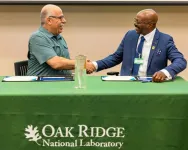(Press-News.org) Cyclists choosing a new helmet can see how much protection different helmets offer, thanks to new safety testing and ratings from Imperial College London.
Researchers at Imperial College London have developed a simple new cycle helmet safety rating system with simple-to-understand scores from 0-5, designed to help buyers select which helmet to buy and assist manufacturers in future helmet design. The system is based on extensive new safety testing experiments on medium-sized helmets at Imperial.
Testing on the UK’s 30 most popular helmets, funded by The Road Safety Trust, revealed significant differences in performance with no link between the price of a helmet and the level of safety it provides the wearer. So, for example a helmet costing £130 did not perform better in tests than one costing £40.
People can check the rating of the adult cycle helmets tested to date on the helmet impact protection effectiveness rating (Hiper) [1] website, and the team plan to add ratings for children’s helmets following further research.
Lead author Dr Claire Baker, from Imperial’s Dyson School of Design Engineering, said: “Until now, there has been limited information about how well cyclists can expect their helmet to protect them during head impact. This is because current safety standards are simply pass/fail and only test direct impact sustained during straight-on head impact. However, evidence from previous studies shows that lasting brain damage occurs in more serious impacts or when the head undergoes rapid rotations during an impact.”
The results are published today in Annals of Biomedical Engineering.
No correlation between price and protection
Cycling offers a cost-effective and environmentally-friendly way to commute, a low-impact way to improve cardiovascular health, muscle strength and joint mobility, and can improve mental health.
Injuries and deaths from cycling have declined in recent years.[2] However, cyclists remain vulnerable road users, and cycling accidents can be serious, with head injuries being one of the main causes of death and life-changing injuries for cyclists involved in collisions. Yet the costs and designs of helmets vary widely and until now there has been no objective ratings information about which helmets on sale in the UK offer cyclists the best protection.
To produce the ranking, the Imperial team tested 30 of the most popular adult helmets on the market, all medium sized, based on a combination of in-lab testing, data from major retailers, and a survey of more than a thousand cyclists.
All cycle helmets sold, and therefore all helmets tested in this study, must have passed regulatory standards to ensure they offer protection.
Dr Baker said: “All helmets sold in Europe must meet the EN1078 minimum safety standard, but we wanted to determine whether some offered better safety protection than others in realistic collision tests. We developed a simple scoring system to rate helmets based on the risk of head injury during a collision. The risk of injury took account of the likelihood of deep brain injuries from head rotation as well as more surface level injuries and potential skull fractures from direct impact. Our scoring ranges from zero for lower protection to five for the best on the market.”
“Interestingly, we found no correlation between price and protection, with the highest-performing helmet being one of the less expensive, retailing at around £50. Our new ratings give consumers objective, evidence-based data to support their buying decisions.”
Evidence from previous studies shows that head rotation is often associated with loss of consciousness and injuries deep in the brain that can be life-changing, for example triggering dementia.
The overall risk was calculated as an average of the linear and the rotational risk, which assumes they have equal importance and presence in real-world casualties. However the researchers say the weighting of these risks should be adjusted in future as more data emerges on the distribution of these injuries and their consequences.
The survey showed that a large proportion of the adult population of all genders wear medium helmets. The use of only medium-sized helmets in this study, which fitted the 57 cm circumference test headform, means that future work will test a wider range of helmet sizes to ensure equitable research.
Senior author Dr Mazdak Ghajari, also from the Dyson School of Design Engineering at Imperial, supervised the research and is also a member of the working group responsible for one of the European standards on helmet safety (CEN/TC158/WG11).
He said: “The science of brain biomechanics has advanced tremendously and we now know much more about how best to protect the human head from serious injury and injuries with long-term effects in a collision.
“We are sharing our findings with helmet manufacturers and those responsible for setting testing standards, so that the industry can keep pace and develop products that offer the best possible protection.
“Thanks to funding from the Road Safety Trust, our research can now help consumers to make an informed choice when they buy a helmet. We believe these ratings will lead to further improvements in helmet designs, providing better protection against a range of head and brain injuries if a cyclist is involved in a fall or collision.”
The Road Safety Trust has extended its funding for three years so that Dr Ghajari and his team can apply their testing and rating techniques to children’s helmets as well as continuing to test the wide range of adult helmets available to buy.
Ruth Purdie OBE, Chief Executive of The Road Safety Trust, which funded the research, said: “In the event of a collision, cycle helmets can play a vital role in preventing and reducing the severity of head injuries.
“That’s why this new rating system is incredibly important. It will show riders which helmets offer the best protection, helping them to make better informed choices.”
The research was funded by the Road Safety Trust and Innovate UK.
For more information contact:
Mon, Weds, Thurs and Fri: Caroline Brogan
caroline.brogan@imperial.ac.uk
+44(0)20 7594 3415
+44(0)7745 650 147
Out of hours press officer mobile: +44 (0)7803 886248
Tues 17 Sept: Hayley Dunning
h.dunning@imperial.ac.uk
+44(0)20 7594 2412
NOTES TO EDITORS:
To access the searchable helmet effectiveness rating see: https://www.hiperhelmets.org/
Reported road casualties in Great Britain: pedal cycle factsheet, 2021: https://www.gov.uk/government/statistics/reported-road-casualties-great-britain-pedal-cyclist-factsheet-2021/reported-road-casualties-in-great-britain-pedal-cycle-factsheet-2021#pedal-cycle-traffic-and-reported-casualties
To download the paper, images, and video see: (specific ratings in table 6 of paper, https://www.hiperhelmets.org/, and in the Box folder) https://imperialcollegelondon.box.com/s/chgjb75se0390lqa9r5mp57frmbfwomi
The paper’s URL, which will go live when the embargo lifts, will be: https://link.springer.com/article/10.1007/s10439-024-03589-8.
About Imperial College London
We are Imperial – a world-leading university for science, technology, engineering, medicine and business (STEMB), where scientific imagination leads to world-changing impact.
As a global top ten university in London, we use science to try to understand more of the universe and improve the lives of more people in it. Across our nine campuses and throughout our Imperial Global network, our 22,000 students, 8,000 staff, and partners work together on scientific discovery, innovation and entrepreneurship. Their work navigates some of the world’s toughest challenges in global health, climate change, AI, business leadership and more.
Founded in 1907, Imperial’s future builds on a distinguished past, having pioneered penicillin, holography and fibre optics. Today, Imperial combines exceptional teaching, world-class facilities and a habit of interdisciplinary practice to unlock scientific imagination.
About Road Safety Trust
The Road Safety Trust is dedicated to achieving zero deaths and serious injuries on UK roads.
To achieve this, The Trust provides funding for practical measures, research, dissemination, and education. It works with partner organisations to use the wealth of knowledge and understanding about what works in practice in order to keep road safety high on the national and local agenda, and influence policy change.
The Trust shares the knowledge acquired from the research and practical interventions it has funded across the road safety sector, as well as the wider community, in order to raise awareness and encourage implementation.
For more information visit www.roadsafetytrust.org.uk
For media enquires contact media@roadsafetytrust.org.uk
END
Levels of protection from different cycle helmets revealed by new ratings
2024-09-18
ELSE PRESS RELEASES FROM THIS DATE:
Pupils with SEND continue to fall behind their peers
2024-09-18
Pupils with special educational needs and disabilities (SEND) are continuing to fall behind their peers with the gap widening despite the introduction of SEND legislation.
This is according to a new study by Durham University which analysed data on 2.5 million Year 6 pupils across four school years from 2014-2019.
The research suggests there is a need to re-evaluate the policies for SEND provision and how pupils with SEND are supported in schools.
It calls for more investment to support SEND pupils and for increased professional development for teachers and teaching assistants.
Using ...
Half of heavier drinkers say calorie labels on alcohol would lead to a change in their drinking habits
2024-09-18
Half of heavier drinkers say calorie labels on alcohol would lead to a change in their drinking habits
Just over half of heavier drinkers in England say they would make changes to their drinking if calorie labels for alcohol were introduced, according to a new study by UCL researchers.
The findings, the researchers said, suggested calorie labels could help some drinkers maintain a healthier weight.
The study, published in the journal BMJ Open, looked at survey responses from 4,683 adults in England to assess the impact that alcohol calorie labelling might have on people’s attitudes and drinking ...
Study first to link operating room design to shorter surgery
2024-09-18
LAWRENCE – Xiaobo Quan is proud that his study is the first of its kind to link operating room design to the length of knee- and hip-replacement surgeries.
Thus, the University of Kansas School of Architecture & Design associate professor believes its findings can be used to optimize spaces that will both produce better outcomes, via shorter surgeries, for patients and boost the hospital’s bottom line.
For the article “Can Operating Room Design Make Orthopedic Surgeries Shorter, Safer, and More Efficient?: A Quasi-Experimental Study,” ---------- link to: https://doi.org/10.1177/19375867241254529 --------- in the journal Health Environments Research & Design, ...
New study uncovers therapeutic inertia in the treatment of women with multiple sclerosis
2024-09-18
A study has revealed significant therapeutic inertia in the treatment of women with multiple sclerosis (MS), highlighting gender disparities that could impact long-term health outcomes for women of childbearing age.1
The findings, presented today at ECTRIMS 2024, suggest that concerns related to pregnancy may lead to delayed or reduced use of disease-modifying treatments (DMTs), even before pregnancy becomes a consideration.
In an extensive analysis of 22,657 patients with relapsing MS (74.2% women) who were on the French ...
Cancer Cooperative Group leaders propose a re-engineering of the nation’s correlative science program for cancer
2024-09-18
With publicly funded correlative science in the nation’s Cancer Cooperative Groups reduced to a trickle, Group leaders propose implementing a long-standing National Academy of Medicine recommendation to bring new money to this area of research through public-private partnerships. They also recommend major process changes to remove significant barriers for researchers to access the biological samples contributed by patients. The current Journal of Clinical Oncology issue features ‘Correlative Science in the Cooperative Group System—Re-Engineering for Success.’
This Position Paper represents consensus among Evanthia Galanis, MD, DSc for the Alliance for Clinical ...
Nawaz named ASME Fellow
2024-09-18
Kashif Nawaz, distinguished researcher and section head for Building Technologies Research at the Department of Energy’s Oak Ridge National Laboratory, has been named a Fellow of the American Society of Mechanical Engineers, or ASME. The Fellow grade recognizes outstanding engineering achievements for members with 10 or more years of active practice.
Nawaz joined ORNL in 2016 as a research scientist in buildings equipment. He specializes in the heating, cooling and dehumidification systems of buildings including the development of novel heat exchangers and enhanced phase-change material ...
U2opia signs license to commercialize anomaly-detection technology for cybersecurity
2024-09-18
U2opia Technology has licensed Situ and Heartbeat, a package of technologies from the Department of Energy’s Oak Ridge National Laboratory that offers a new method for advanced cybersecurity monitoring in real time. Situ, which discovers and understands otherwise-undetectable events by analyzing security data, will go to the market through a commercial license. The company will continue to explore opportunities for Heartbeat, which detects cyber attacks by focusing on the physical behavior of a protected device, through a research and development license.
U2opia Technology, a woman- and minority- led company, is directed by Maurice Singleton III, chief executive officer, ...
Explaining dramatic planetwide changes after world’s last ‘Snowball Earth’ event
2024-09-18
Some of the most dramatic climatic events in our planet’s history are “Snowball Earth” events that happened hundreds of millions of years ago, when almost the entire planet was encased in ice up to 0.6 miles (1 kilometer) thick.
These “Snowball Earth” events have happened only a handful of times and do not occur on regular cycles. Each lasts for millions of years or tens of millions of years and is followed by dramatic warming, but the details of these transitions are poorly ...
Cleveland Clinic study is first to show success in treating rare blood disorder
2024-09-18
Wednesday, September 18, 2024, CLEVELAND: A clinical trial has demonstrated that the cancer drug pomalidomide is safe and effective in treating hereditary hemorrhagic telangiectasia (HHT), a rare bleeding disorder that impacts more than 1 in 5,000 people worldwide. The trial, led by Keith McCrae, M.D., of Cleveland Clinic and supported by the National Institutes of Health, was stopped early because of these successful findings, and has been published in the New England Journal of Medicine.
The impetus for this trial was a single patient. About ...
Bone marrow cancer drug shows success in treatment of rare blood disorder
2024-09-18
A clinical trial supported by the National Institutes of Health (NIH) was stopped early after researchers found sufficient evidence that a drug used to treat bone marrow cancer and Kaposi sarcoma is safe and effective in treating hereditary hemorrhagic telangiectasia (HHT), a rare bleeding disorder that affects 1 in 5,000 people worldwide. The trial results, which are published in the New England Journal of Medicine, detail how patients with HHT given the drug, called pomalidomide, experienced a significant reduction in the severity of nosebleeds, needed fewer of the blood transfusions and iron infusions that HHT often demands, ...



